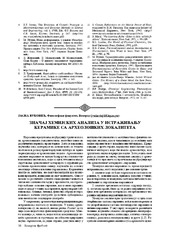Značaj hemijskih analiza u istraživanju keramike sa arheoloških lokaliteta
The significance of chemical analyses in investigations of archaeological potter
| dc.creator | Vuković, Jasna | |
| dc.date.accessioned | 2021-10-12T10:32:53Z | |
| dc.date.available | 2021-10-12T10:32:53Z | |
| dc.date.issued | 2005 | |
| dc.identifier.issn | 0440-6826 | |
| dc.identifier.uri | http://reff.f.bg.ac.rs/handle/123456789/484 | |
| dc.description.abstract | Keramika predstavlja najbrojniju grupu nalaza na arheološkim lokalitetima posebno onim iz različitih perioda praistorije. Zato je keramika najčešće onaj materijal na osnovu koga se tumače nastanak i razvoj praistorijskih kultura i vrše periodizacije i hronološke podele. Arheološke analize keramike se mahom baziraju na stilsko-tipološkim analizama, koje za cilj uglavnom imaju svrstavanje arheološkog materijala u određeni relativno hronološki okvir, najčešće na osnovu evolucije oblika i načina ukrašavanja. Keramičke posude se, međutim, ne smeju posmatrati kao izolovani predmeti izdvojeni od svog konteksta. One su vezane za različite aspekte svakodnevnog života i čitav niz aktivnosti ljudi u prošlosti, od strategije nabavke osnovne sirovine, kao i onih sirovina koje se dodaju u glinu kao primese preko izrade (oblikovanje, sušenje, pečenje, finalna obrada i ukrašavanje) načina upotrebe do načina odbacivanja ili eventualne sekundarne upotrebe. | sr |
| dc.description.abstract | The author emphasizes significance of chemical analyses in investigations of archaeological pottery. There are two groups of chemical analyses widely accepted by modern archaeology. Analytical techniques such as atomic absorption spectrophotometry, raman spectroscopy, neutron activation analysis, optical spectroscopy and others are used in compositional analyses of raw materials for manufacturing pottery. These materials include - clays no plastics and pigments. The results of elemental analyses are important in archaeological interpretation of issues related to procurement of raw materials, manufacturing techniques, exchange and trade. The second group of analyses belongs to the special discipline in archaeological science bimolecular archaeology. This discipline is focused on analyzing residues of ancient lipids absorbed in porous walls of ceramic vessels, as well as visible, charred organic residues on the interiors of pottery. Implemented techniques are gas chromatography, gas chromatography/mass spectrometry and stable isotopic analysis. Results of these analyses provide relevant evidence on food habits, preparation and consumption of food, as well as information which helps archaeologists to understand and determine the actual use of ceramic vessels. Author emphasizes the fact that both groups of analysis enrich the science of archaeology with new sets of arguments for the study of lifestyle and social organization of ancient populations. | en |
| dc.publisher | Srpsko hemijsko društvo, Beograd | |
| dc.rights | openAccess | |
| dc.source | Hemijski pregled | |
| dc.title | Značaj hemijskih analiza u istraživanju keramike sa arheoloških lokaliteta | sr |
| dc.title | The significance of chemical analyses in investigations of archaeological potter | en |
| dc.type | article | |
| dc.rights.license | ARR | |
| dc.citation.epage | 41 | |
| dc.citation.issue | 2 | |
| dc.citation.other | 46(2): 38-41 | |
| dc.citation.spage | 38 | |
| dc.citation.volume | 46 | |
| dc.identifier.fulltext | http://reff.f.bg.ac.rs/bitstream/id/2030/481.pdf | |
| dc.identifier.rcub | https://hdl.handle.net/21.15107/rcub_reff_484 | |
| dc.type.version | publishedVersion |

